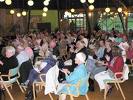
The answer to the title question is that it does not have to become ineffective. Well, what size adult Sunday School class is most effective? There are so many variables in order to answer this question that it is impossible to give one set answer. The setting has significant influence. The teacher and leaders make a difference. Space is relevant. Participant target and demographics must be considered.
Besides these thoughts, the question needs follow up. Different size adult classes may be more effective at different things. Larger classes may be more effective at providing a variety of ministry and service opportunities than smaller classes. Smaller classes may do a better job of ministry to each other. On average, which size is better at getting people involved in the lesson? It totally depends on the teacher and class leaders. I have been in large and small classes with few to no people involved. And I have been in large and small classes in which every person was engaged and participating in the lesson.
Yes, it is true that it is more work for a larger class to keep up with members, absentees, and prospects because of sheer volume. That is why the percentage of attendance in many larger classes is lower than it is in many medium and smaller classes. But I have taught a large class that was well-organized for contact with, prayer for, and ministry to each of these three groups–and the percentage of attendance was good. And I divided the group into smaller groups and achieved a high percentage of participation in the study of God’s Word.
Now, I have to be honest. I have a bias toward small to medium-sized classes. That because over the years I have personally seen more lives changed, people accept Jesus, disciples developed, leaders launched, ministry carried out, and needs met through this size classes. But in more recent years I have begun seeing the rise of really effective communities in large classes. These are more frequently found in medium and large churches.
That observation led me in January of last year to sit down with Steve Lizzio to talk about adult Bible fellowships (ABF) and midsize groups. Steve is the Pastor of Adult Ministries at Hope Church in Mason, Ohio (Cincinnati area), and the Director of ABF Resources. Steve and a great leadership group put together an annual ABF Conference at Hope Church (press the link to see the promotional postcard for the event on November 14-15, 2008).
As Steve and I talked about his philosophy of ABF and midsize groups, I could sense his passion for the church and for effective communities within groups. The longer we talked the more I realized that what he was talking about was effective Sunday School. In a fresh way, it made me realize that large groups did not have to be discouraged–only ineffective groups (which is true of all sizes). I have come to think that there could be a benefit from having all three size groups in a church that has the people and space to accommodate them.
I think it is healthy to know where you want to go and to understand the best way to get there, and that may necessitate focusing upon one or two of these three size groups in your ministry. Each of them (whether small, midsize, or ABF) should be encouraged to launch new groups in healthy ways. Each should be coached toward effectiveness. Each should be expected to care well for members and guests. Each should be expected to lead attenders to serve. Each should be expected to be communities.
So, should i t be small, midsize, or large classes? Yes! But only if they are effective. Only if they make a difference. Only if they help carry out the Great Commission. Don’t be mediocre. Be revolutionary!
Leave a Reply